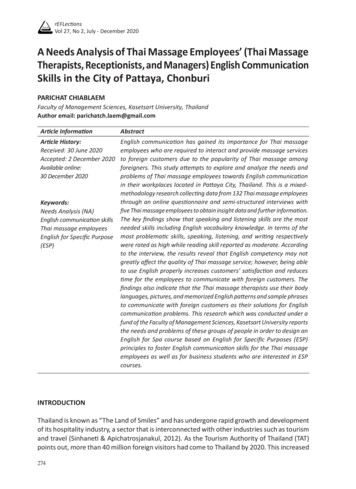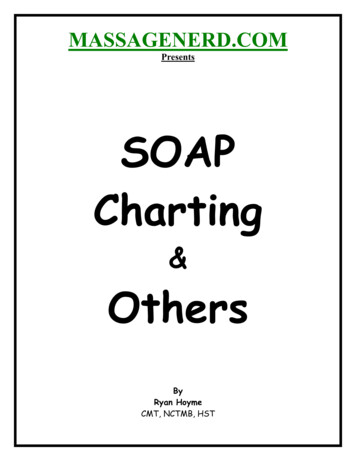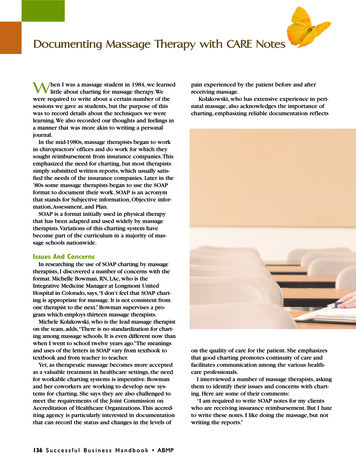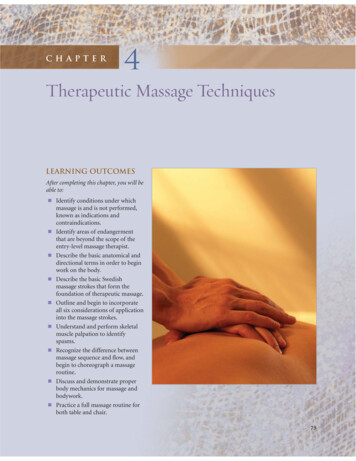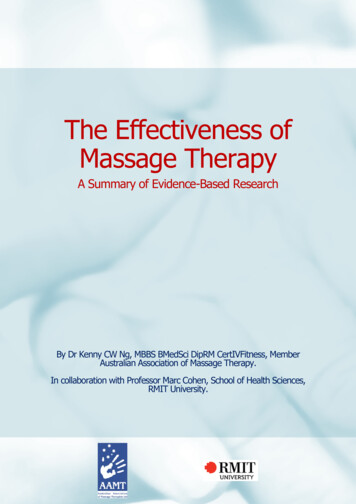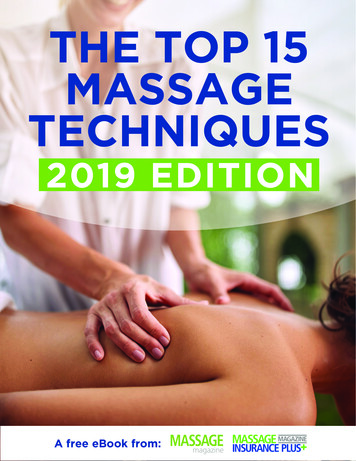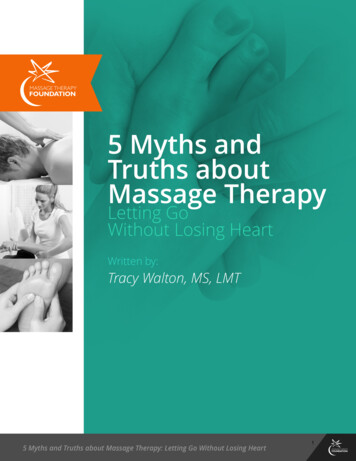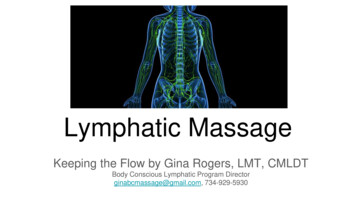
Transcription
Lymphatic MassageKeeping the Flow by Gina Rogers, LMT, CMLDTBody Conscious Lymphatic Program Directorginabcmassage@gmail.com, 734-929-5930
What is lymphatic massage? Lymphatic Massage is aka manual lymphdrainage (MLD). Developed first in France in 1932 by Danishphysiotherapist Dr. Emil Vodder. Since 1932 MLD has been widely researchedand used in Europe. Migrated to the United States over the lastthirty years. In this country, we hear most about MLD in thetreatment of lymphedema, but has so manymore applications.
Manual lymph drainage (MLD) is: A light touch manual therapy technique using different gentle and slowhand movements. Assists the lymphatic system function by promoting lymphangiomotoricty. Lymph fluid usually flows at a rate of 10-12 bpm. Unlike the cardiac system,the lymphatic system does not have a pump, it relies on muscle movement,manual lymph drainage, or hydrostatic pressure. Following an hour long lymphatic massage, the flow rate will beapproximately 100 to 120 bpm, and will gradually slow over the proceeding48 hours.
The lymphatic system Made up of an extensive network of: vesselsglandsductsnodespasses through almost all of the tissue in the human body, including the brain. Allows for the collection and transport of lymph fluid. Lymph fluid is made up of a variety of substances. proteins, fats, salts, glucose, water, cellular debris, and white blood cells.
The body’s sewer system Absorbs excess interstitial fluid, hormones, and cellular waste. Breaks down proteins and other cellular debris that are too big for the cardiacsystem to break down. Lymph nodes contain lymphocytes and phagocytes to break down thoseproteins, pathogens and other cellular waste. “Clean” lymph fluid is transported back through lymph ducts to the veins. Once lymph fluid is in our veins it’s called plasma.This is an important system!
Things that will slow the lymphatic system: Fighting off an infection, bacterial or viral.Primary and secondary lymphedemaSurgeryTraumatic eventPregnancyLifestyle Sedentary vs active Lymphatic system relies on muscle movement for lymph flow. The less muscle movement, the slowerthe system. Sitting for long stretches of time causes muscle stiffness, and impedes the thoracic duct. Standing in one place for long periods of time will cause fluid to pool in the lower extremities. Diet High in sugar High in protein High in fat Heavy coffee drinkers-grounds are broken down by lymph system Dehydration- Not providing the body with enough fluid
Sluggish lymph system results in Edema Just like when a septic system gets clogged, the fluid has no where to go and ends up buildingup, just hanging around waiting. Sitting upon muscles and nerves, causing stiffness and pain. Adhesions and scar tissue Eventually this protein rich fluid begins to harden creating adhesions and fibrotic tissue withinand around organs and muscles. Creating pain, dysfunction, and restricted range of motion. Illness Flow is stagnating so its not getting through the lymph nodes where the pathogens would betaken care of, allowing them to get into the surrounding cells. Literally breeding disease.Protein rich fluid that is turning rancid will cause inflammation.
Contraindications for MLD Major organ failure/ Cardiac DecompensationHypotensionFever/acute inflammationInfluenzaDeep vein thrombosis within two yearsBlood thinners (depends on integrity of the skin)Conditions of chronic inflammation need to be approached cautiously.Infection/ must be on antibiotics for at least 48 hours.Recent asthma attackFirst trimester of pregnancyAny trimester of pregnancy when still experiencing morning sicknessDental infectionThose undergoing active oncology treatments would need permission from their treatment team.
Some conditions that have been proven to benefit from MLD: Lymphedema- best to see a completedecongestive therapist for treatment phase. LipodemaPost surgery swellingLyme disease*Chronic sinusitisStrokeHead injuries/ConcussionsParkinson’s DiseaseAmputation/Phantom painsBurnsFracturesConstipationSwelling during pregnancy Whiplash syndromeDupuytren’s contractureBursitisTendinitis, tendinous, Periarthriticsyndrome, tendosynovitis, epicondylitis.SclerodermaLupus ErythematosisGout in subacute or chronic phaseSpondylosisPTSDCystic FibrosisDiverticulosisAcne/RosaceaAlzheimer’s Disease
More details on diseases MLD can be used to treatcan be found in:MLD has been used inEurope since 1932, thisbook is a culmination ofthat experience, research,and practical application.
A lymphatic massage session: Similar to regular massage clients are draped on a massage table.Oil may be used if clients skin is especially taut, but only in a small amount. Usually no lotions or oilsare used.15- to 60- minutes in length.Prenatal clients in their second and third trimester start with 15 minute sessions.Frequency of lymphatic work can be daily for some conditions and up to every 2 or 3 months forsomeone healthier and without medical conditions.Clients remove all constrictive clothing and/or bandaging, unless not cleared to do so by theirphysician.Clients who are seeking lymphatic massage for edema will be measured before a session, andsome will be remeasured after the session, depending on session goals.Clients who are receiving five series lymphatic massage will be measured prior to the first session,and proceeding the last session in the series.
Possible side effects ofMLD Increased relaxationIncrease in urinationPossible DiarrheaFatiguePossible nauseaDizziness when first sitting up.Decreased edemaIncrease in energyImpediment to treatmentcomplianceScheduling- For MLD to be the most effective forsome treatments clients need to be seen daily for acertain number of weeks. This can be difficult for botha clients schedule or a therapists schedule.Financial- Lymphatic treatments in the state ofMichigan range in price from 70 to 160 an hour.While OT’s, PT’s, MD’s, and RN’s can usually chargeinsurance companies directly, it’s rare to find thoselicensed individuals who can do an hour in theirschedule every day, and there still may be a copay.For MT’s, most insurance companies will not let us billdirectly, and while some may reimburse the client, it’sstill an expensive initial investment.
Lyme Disease Case Study43 year old woman Lyme disease diagnosed one year prior resulting in patient being completelydisabled. Currently diagnosed with CD2 Deficiency Environmental allergies Thrombophilia “Brain fog” Vertigo Fatigue Depression
Four sessions were done consecutively, four days in a row.Each session was an hour long.Sessions were done completely supine, with client semi reclined due to severe vertigo.Focus was given to head and neck nodes due to the severity of vertigo client was experiencing.Prior to first session the client filled out a questionnaire answering what symptoms she was experiencingat that time, and the degree of severity. Client rated symptoms from mildly impacting (rated as a 1) her lifeon that day, moderately impacting her life (rated as a 2), to severely impacting her life (rated as a 3).Prior to first session:Following fourth session:1-Sleep impairment1-Neuropathy1-Headaches1-Heart issues1-Joint pain2-Muscle aches3-Fatigue3-Depression3-Cognitive impairment3-Vertigo1-Sleep impairment0-Neuropathy0-Headache0-Heart issue0-Joint pain0-Muscle aches1-Fatigue3-Depression1-Cognitive impairment3-Vertigo
Conclusion The lymphatic system is important to a person’s overall health. Lymphatic massage can be both a positive main therapy or adjunct therapyfor many conditions. Medical professionals are important for identifying patients that will potentiallybenefit from this modality. Talk about this modality to everyone! The more people know about it’sbenefits, the more we can bring this needed service to those who will mostbenefit from it.
Self lymphatic massage for the head and neck:1. Lightlyplacebothhandsalong thesides ofthe neck,underthe jaw.2. Lightly push theskin posteriorly.
3. After pushing the skin towards the posterior neck, in one motion then push the skindownwards, inferiorly, like you’re drawing the letter “C”. At the end of the “C” let go.4. At the end of the“C” let go beforestarting the nextrepetition.5. Do seven totwelve repetitions.You will know youhad the correctamount of pressureif the skin bouncesback. If the skindoes not bounceback, try the nextone with lesspressure.
1. Hold yourhands up sothat yoursecond andthird fingersform a “V”.
2. Place the “V” of yourfingers, lightly, posteriorlyand anteriorly, on both sidesof your earlobe.
3. Slowly and gently, justengaging the skin, pull yourfingers down towards yourchin.4. Without letting go,rotated your fingers upwardand your palm down.5. At the end of themovement remember to letgo before going to the nextrepetition.Do seven to twelverepetitions.
1. Place your fingerslightly along eachside of your mouth,starting at the cornerof your nose.
2. Lightly,pull the skininto little halfcircles,going awayfrom themouth fromthe end ofyour nose toyour jawline.Letting go ofthe skin aftereach halfcircle.From noseto jaw is onerepetition.Do five totwelverepetitions.
End with doing seven to twelve more repetitions on the neck. Making sure to let go of the skinafter each repetition.
Thank you for taking time out of your busy schedule to learn moreabout lymphatic massage.If you have any questions please feel free to call or email me at the following contact information:Body Conscious Massage Therapy2201 Medford RdAnn Arbor, MI 48104ginabcmassage@gmail.com734-929-5930
book is a culmination of that experience, research, and practical application. A lymphatic massage session: Similar to regular massage clients are draped on a massage table. Oil may be used if clients skin is especially taut, but only in a small amount. Usually no lotions or oils are used. 15- to 60- minutes in length. Prenatal clients in their second and third trimester start with 15 minute .
